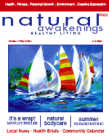| |
|
 |
 Web reprint by permission from
Web reprint by permission from
Natural Triad (formally Natural Awakenings)
July, 2004, page 14 and 15
Bowen Therapy - A road out of Pain
By Kent McKeithan, Bowen practitioner, Winston-Salem, North Carolina
|
|
 "It was the most horrible pain
I could have imagined. They
had to [literally] carry me to the
hospital because I couldn’t walk."
Four years ago, Doris Clark,
long-time educator, mother of
two (now-grown) and an active
grandmother, was going about her
life in her usual enthusiastic way.
There’d been a lot of stress in her
life lately – her mom dying after a
long bout with cancer and health
challenges to her husband, but
she was more than coping when,
apparently out of the blue, the pain struck.
"It was the most horrible pain
I could have imagined. They
had to [literally] carry me to the
hospital because I couldn’t walk."
Four years ago, Doris Clark,
long-time educator, mother of
two (now-grown) and an active
grandmother, was going about her
life in her usual enthusiastic way.
There’d been a lot of stress in her
life lately – her mom dying after a
long bout with cancer and health
challenges to her husband, but
she was more than coping when,
apparently out of the blue, the pain struck.
"It began as a little twinge, then it would shoot across my
back from one side to the other. It grew worse during the day,
and began to travel down my leg, until finally I was just bent
over." That’s when she was taken to a hospital in Winston-Salem
where she was diagnosed as having a pinched nerve at
the fourth lumbar vertebra.
"I spent seven days in the hospital. I had a full range of
X-rays, an MRI and a CAT scan. They administered shock
treatment to my legs, then I went for a full series of physical
therapy sessions. Nothing was working." She went to a
hospital’s pain center, still with no relief.
She says the entire sequence was repeated -- MRI, CAT
scan, another round of physical therapy sessions—and a
bone scan was added. "In the end [her physician] told me,
"There’s nothing more we can do. Your condition is inoperable.
You’re just going to have to learn to live with your
pain." There was the clear implication that there were only
three alternatives: bed rest with medication, physical therapy
or surgery, a fourth being live with the pain.
Effective Treatment
There was a time of shock and resignation, but as the pain
continued in unrelenting intensity over time, Clark’s life
began to shut down.
"With my husband’s stroke, he could no longer work
with me, so we’d had to let our vegetable garden go. Then,
|
|
as my pain got worse, I quit working with our flowers and
shrubbery. I couldn’t even go to the mall and shop. I was really
just existing."
Time passed, and one day she remembered an article
she’d read in the Winston-Salem Journal about some kind of
new therapy for pain. In fact, she’d clipped it out and saved
it. She finally found it and decided to take a chance on this
new Bowen Therapy.
Her first session yielded some immediate relief (the first,
she reports, in four years), but the pain returned. Warned that
this indeed might occur, she returned for the second session,
concerned but hopeful. Progress from the second session was
deeper and more permanent:
"I had a wonderful week! I went out and pulled weeds
and trimmed the monkey grass. I haven’t been able to do that
in four years. I love spring,"
Recovery
Two weeks elapsed before her third session because she
contracted a viral infection. Reporting that she continued her
exercises except during the most intense infection time, she
also continued to walk, as instructed. When she did return,
she reported, "When the pain gets bad, it only goes to a 6
or 7 [on a scale of 1–10], instead of a 7–14! I can go to the
mall and shop for an hour- and-a-half. I’d like there to be no
pain, but I’m very pleased with my progress."
Clark has experienced two further sessions, and is
actively participating in her own full recovery. "I am thrilled
with the way this is going!
Often, Bowen Therapy yields complete results in three to
four sessions. In Clark’s case, the injury/dysfunction was both
severe and of long-standing duration, a combination which
can require more extensive treatment. Her courage and willingness
to participate with appropriate stretching, exercise
and walking has already shortened her recovery period.
Bowen Therapy?
Doris Clark is sharing her experience with the medical system
in comparison with that of Bowen Therapy, which is a
treatment modality developed by Tom Bowen of Australia in
[continued below]
|
Page 14, July, 2004 
|
 the middle 1950’s. During his lifetime, Bowen brought profound
pain relief and permanent healing to many thousands
of people. Since his death, through the work of those who’ve
followed in his footsteps, millions worldwide have permanently
overcome dysfunctions ranging from Tempromandibular
Joint Syndrome, through the pain of Degenerative Disc
Disease, Carpal Tunnel Syndrome, to Tennis Elbow and, and
Plantar Fasciitis, to name a few.
the middle 1950’s. During his lifetime, Bowen brought profound
pain relief and permanent healing to many thousands
of people. Since his death, through the work of those who’ve
followed in his footsteps, millions worldwide have permanently
overcome dysfunctions ranging from Tempromandibular
Joint Syndrome, through the pain of Degenerative Disc
Disease, Carpal Tunnel Syndrome, to Tennis Elbow and, and
Plantar Fasciitis, to name a few.
What Is It?
Bowen Therapy, taught in this country under the names
Bowtech©, Neurostructural Integration Technique© (NST)
and Neural Touch©, is a powerful system of intervention in
dysfunctional musculo-skeletal patterns. These dysfunctional
patterns may be acute or long-held; they may be physical trauma
induced or the result of emotional wounding held in
the body.
What Happens In The Body?
Operating through the network of fascial tissue that infuses
the body, the technique itself shifts fascial tissue from a gel
(relatively hard, less pliable) state, to a sol (optimally pliable
state). Evidence is that this takes effect at the golgi tendon
level, such that fibers, which have been chronically activated,
or “switched on,” are deactivated; and vice-versa for
those that are switched “off.” The result is not a reversal from
“on” to “off,” but a return to tonus, a relaxed state of preparedness
to act. Appropriately applied throughout the body
by the practitioner, the technique not only provides release
at the myo-fibril level, but cumulatively at the whole body
level. This means that all of the compensatory relationships
that have sprung up in the body in reaction to the trauma are
corrected in the proper order, fiber-by-fiber.
|
|
How Does A Session Proceed?
The technique is administered beginning with the client lying
prone. The practitioner addresses the client’s body with
manipulations called “moves.” These moves, gentle rollover
motions, are like a plucking or strumming motion and may
be perceived by one client as a tweak or a pinch, as a rubbing
motion by another, or barely noticeable by others. The
moves are inserted at key points that have been found to provide
communication with specific body areas, encouraging
the body, in all its minute parts, to return to the relationships
whose designs or patterns are held in the chromosomes.
What Happens Next?
This release and return begins immediately, and continues to
take place over a period of days, during which time the client
may undergo a range of responses including simple, quick
release, a return of some portion of the pain of the original
physical trauma, emotional upset, nausea, headaches, lethargy,
or extreme high energy. While from the client’s point
of view a quick healing is obviously the ideal result, the practitioner
has limited control over this aspect of the healing and
must support the client while the process is occurring. A list
of recommended actions is provided to the client on leaving
the office; phone support is available, and occasionally extra
treatments are arranged.
A client will usually notice some results immediately.
For some, one session is sufficient; and in most cases, clients
will find resolution of the presenting complaint within three
weekly sessions. As in Clark’s case, complex dysfunction of
long duration may require longer treatment.
McKeithan Pain Treatment Center.welcomes your appointment, or your
call for more information. McKeithan Pain Treatment Center is located
at 1169 Edgebrook Dr, Winston-Salem, North Carolina 27106. Phone
336-761-0501
www.McKeithanPTC.com
|
Web reprint by permission from
NaturalTriad.com
July 2004 Page 15
|
Bowendirectory.com is not affiliated with any therapeutic or teaching organization. Neither do we specifically endorse the trainings or teaching of any organization. We do not endorse any practitioner. We only provide a directory where Bowen practitioners can be located. You take full responsibility for the practitioner you choose, and or training you participate in. The Bowen Directory can not be held responsible in any way for this historical information.
|  | |
|
 Web reprint by permission from
Web reprint by permission from
 "It was the most horrible pain
I could have imagined. They
had to [literally] carry me to the
hospital because I couldn’t walk."
Four years ago, Doris Clark,
long-time educator, mother of
two (now-grown) and an active
grandmother, was going about her
life in her usual enthusiastic way.
There’d been a lot of stress in her
life lately – her mom dying after a
long bout with cancer and health
challenges to her husband, but
she was more than coping when,
apparently out of the blue, the pain struck.
"It was the most horrible pain
I could have imagined. They
had to [literally] carry me to the
hospital because I couldn’t walk."
Four years ago, Doris Clark,
long-time educator, mother of
two (now-grown) and an active
grandmother, was going about her
life in her usual enthusiastic way.
There’d been a lot of stress in her
life lately – her mom dying after a
long bout with cancer and health
challenges to her husband, but
she was more than coping when,
apparently out of the blue, the pain struck.
 the middle 1950’s. During his lifetime, Bowen brought profound
pain relief and permanent healing to many thousands
of people. Since his death, through the work of those who’ve
followed in his footsteps, millions worldwide have permanently
overcome dysfunctions ranging from Tempromandibular
Joint Syndrome, through the pain of Degenerative Disc
Disease, Carpal Tunnel Syndrome, to Tennis Elbow and, and
Plantar Fasciitis, to name a few.
the middle 1950’s. During his lifetime, Bowen brought profound
pain relief and permanent healing to many thousands
of people. Since his death, through the work of those who’ve
followed in his footsteps, millions worldwide have permanently
overcome dysfunctions ranging from Tempromandibular
Joint Syndrome, through the pain of Degenerative Disc
Disease, Carpal Tunnel Syndrome, to Tennis Elbow and, and
Plantar Fasciitis, to name a few.